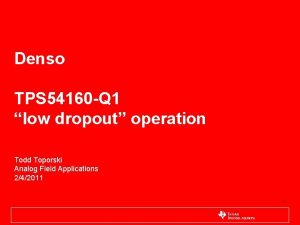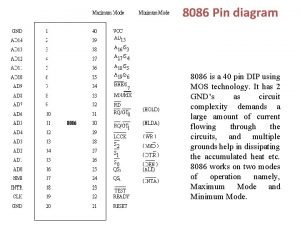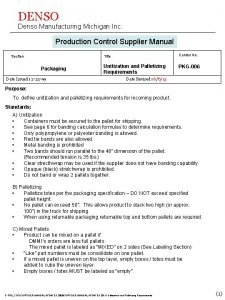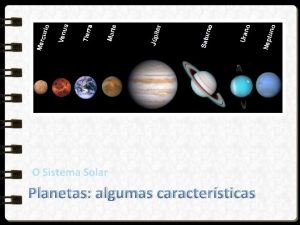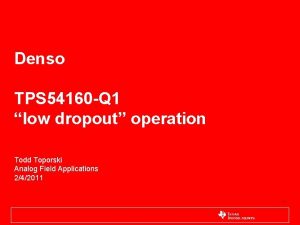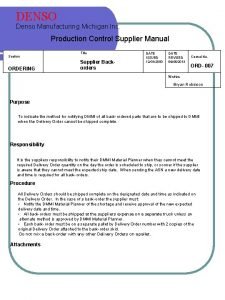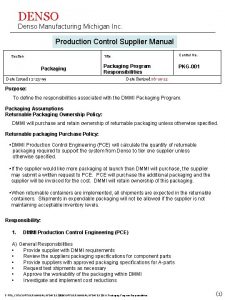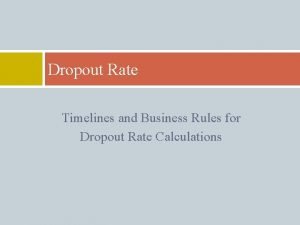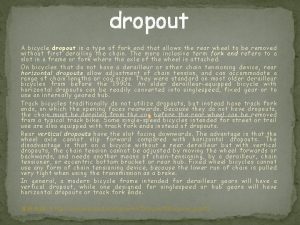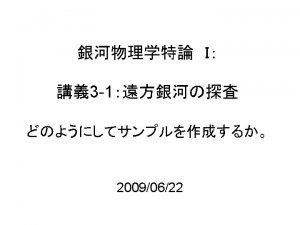Denso TPS 54160 Q 1 low dropout operation













- Slides: 13

Denso TPS 54160 -Q 1 “low dropout” operation Todd Toporski Analog Field Applications 2/4/2011 1

TPS 54160 -Q 1 Overview • • • Buck circuit recommended to Denso Description of “low dropout” operation What “low dropout” condition looks like Work-around used by Denso-Japan TI recommendations 2

TPS 54160 -Q 1 Circuit For Denso Switcher Pro design: Vin_min = 7 V, Vin_max = 24 V (continuous) Vout = 5 V, Iout_max = 500 m. A, Fsw = 400 k. Hz In “light load” conditions, with nearly 0 A in the inductor, PH = VOUT (approximately) and D 1 does NOT conduct during OFF cycle. Therefore, PH is not pulled below Vout to help charge BOOT cap during OFF cycle. This is issue when VIN is low (within 2. 1 V of Vout). 3

Description of “low dropout” operation Page 14 of TPS 54160 -Q 1 datasheet: 4

Description of “low dropout” operation (continued) Page 14 of TPS 54160 -Q 1 datasheet: 5

Description of “low dropout” operation (continued) Page 14 of TPS 54160 -Q 1 datasheet: 6

Description of “low dropout” operation (continued) • To reduce power consumption in light load conditions, TPS 54160 -Q 1 uses a BOOTSTRAP circuit for driving the gate of the internal highside FET. • Another method to supply gate voltage for driving internal highside FET is to use a CHARGE PUMP. • Disadvantage of CHARGE PUMP is it requires clock and consumes more quiescent current. Advantage of BOOTSTRAP is it does not require a clock, and it consumes less quiescent current. • Advantage of CHARGE PUMP is it provides better FET drive in “low dropout” conditions. Disadvantage of BOOTSTRAP is it can be problematic in “low dropout” conditions for driving the FET. • The BOOTSTRAP & “low dropout” limitation experienced on TPS 54160 -Q 1 is similarly experienced on other buck switchers using BOOTSTRAP. 7

What “low dropout” condition looks like Vin = 6 V Vout = 5 V Iout = 500 u. A 8

What “low dropout” condition looks like Vin = 6 V Vout = 5 V Iout = 500 u. A In light load condition, Vin – Vout > 2. 1 V (or BOOT-PH > 2. 1 V) prevents switcher from reaching UVLO and turning off. • For Vout = 5 V, Vin < 7. 1 V, UVLO will be reached as BOOT cap discharges and switcher turns off. Therefore, at Vin = 6 V (this example) UVLO is reached. • VOUT decays until Vin – Vout (or BOOT-PH) > 2. 1 V, then switcher turns on again to regulate to Vout = 5 V. As soon as boot cap discharges to < 2. 1 V, UVLO is reached again. • Cycle repeats itself. 9

Work-around used by Denso – Japan • At Denso & TI meeting in Southfied, MI on Jan. 21, 2011, it was discussed with TI that Denso-Japan had used a “work-around” for TPS 54160 dropout issue. • Below is example of the implementation using a diode and resistor (39 k) on PH node. * Denso mentioned that TI engineer in Japan came up with work-around circuit. 10

How “work-around” circuit works During “normal” buck operation with current in inductor: Switch turns ON • Extra diode conducts and energizes inductor with current, D 1 blocks current. • 39 k resistor to GND sinks small current equal to VIN/39 k. Switch turns OFF • D 1 conducts & PH 2 is diode voltage drop below GND • Extra diode conducts to bring PH 1 close to PH 2 voltage, bootstrap charges During “light load current” condition with ~0 A in inductor Switch turns ON • Extra diode conducts and energizes inductor with current, D 1 blocks current. • Output regulates to VOUT. Switch turns OFF • PH 2 = VOUT since D 1 does not conduct. • Extra diode blocks PH 2 voltage so that 39 k can pull PH 1 towards GND to recharge BOOT cap so BOOT-PH > 2. 1 V 11

What “work-around” looks like Vin = 6 V Vout = 5 V Iout = 500 u. A • Vout regulates properly • BOOT – PH reaches 3. 76 V during switch off cycle • Pulse-skipping regulation is maintained until load increases. 12

TI Recommendations & Summary • Work-around circuit appears to work for helping dropout condition, but should be tested over all conditions deemed necessary by Denso. • Drawback of “work-around” circuit is it dissipates more losses (across diode) when load current increases. For 500 m. A application these losses are not very large. • For larger load currents, such as 1 A or higher, the “work-around” circuit will dissipate more power across the diode and this should be accounted for in the design. 13
 Denso tps
Denso tps Ott dropout
Ott dropout High school dropout kanye
High school dropout kanye Questionnaire for dropout students
Questionnaire for dropout students Dropout 線上看
Dropout 線上看 Reset pin in 8086
Reset pin in 8086 Diff between inguinal and femoral hernia
Diff between inguinal and femoral hernia Significant figures
Significant figures Low voltage = low hazard
Low voltage = low hazard Mid = low + (high - low) / 2
Mid = low + (high - low) / 2 Low dominance and low sociability
Low dominance and low sociability Torre di frazionamento immagini
Torre di frazionamento immagini Denso manufacturing michigan
Denso manufacturing michigan Planeta menos denso del sistema solar
Planeta menos denso del sistema solar
